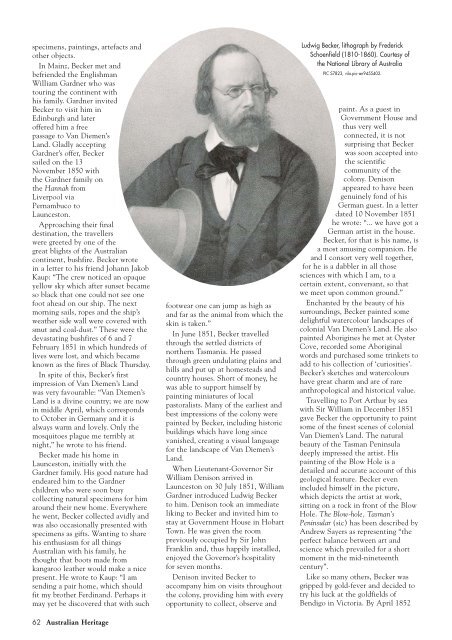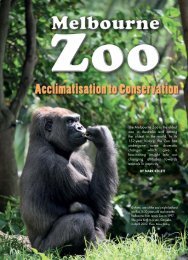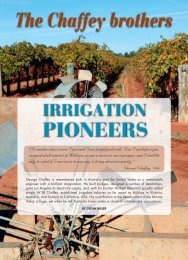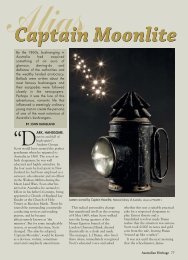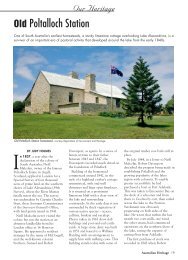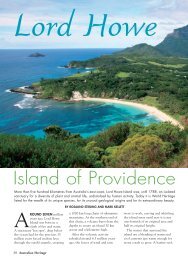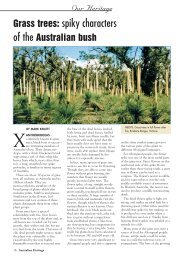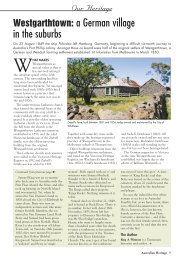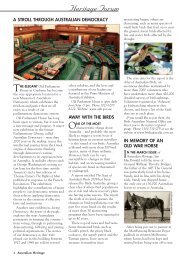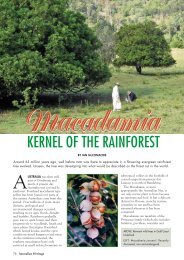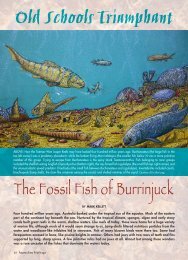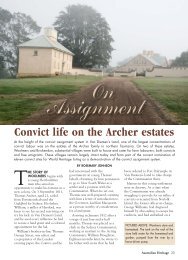Heritage 0306_Ludwig Becker.pdf - Australian Heritage Magazine
Heritage 0306_Ludwig Becker.pdf - Australian Heritage Magazine
Heritage 0306_Ludwig Becker.pdf - Australian Heritage Magazine
Create successful ePaper yourself
Turn your PDF publications into a flip-book with our unique Google optimized e-Paper software.
specimens, paintings, artefacts and<br />
other objects.<br />
In Mainz, <strong>Becker</strong> met and<br />
befriended the Englishman<br />
William Gardner who was<br />
touring the continent with<br />
his family. Gardner invited<br />
<strong>Becker</strong> to visit him in<br />
Edinburgh and later<br />
offered him a free<br />
passage to Van Diemen’s<br />
Land. Gladly accepting<br />
Gardner’s offer, <strong>Becker</strong><br />
sailed on the 13<br />
November 1850 with<br />
the Gardner family on<br />
the Hannah from<br />
Liverpool via<br />
Pernambuco to<br />
Launceston.<br />
Approaching their final<br />
destination, the travellers<br />
were greeted by one of the<br />
great blights of the <strong>Australian</strong><br />
continent, bushfire. <strong>Becker</strong> wrote<br />
in a letter to his friend Johann Jakob<br />
Kaup: “The crew noticed an opaque<br />
yellow sky which after sunset became<br />
so black that one could not see one<br />
foot ahead on our ship. The next<br />
morning sails, ropes and the ship’s<br />
weather side wall were covered with<br />
smut and coal-dust.” These were the<br />
devastating bushfires of 6 and 7<br />
February 1851 in which hundreds of<br />
lives were lost, and which became<br />
known as the fires of Black Thursday.<br />
In spite of this, <strong>Becker</strong>’s first<br />
impression of Van Diemen’s Land<br />
was very favourable: “Van Diemen’s<br />
Land is a divine country; we are now<br />
in middle April, which corresponds<br />
to October in Germany and it is<br />
always warm and lovely. Only the<br />
mosquitoes plague me terribly at<br />
night,” he wrote to his friend.<br />
<strong>Becker</strong> made his home in<br />
Launceston, initially with the<br />
Gardner family. His good nature had<br />
endeared him to the Gardner<br />
children who were soon busy<br />
collecting natural specimens for him<br />
around their new home. Everywhere<br />
he went, <strong>Becker</strong> collected avidly and<br />
was also occasionally presented with<br />
specimens as gifts. Wanting to share<br />
his enthusiasm for all things<br />
<strong>Australian</strong> with his family, he<br />
thought that boots made from<br />
kangaroo leather would make a nice<br />
present. He wrote to Kaup: “I am<br />
sending a pair home, which should<br />
fit my brother Ferdinand. Perhaps it<br />
may yet be discovered that with such<br />
62 <strong>Australian</strong> <strong>Heritage</strong><br />
footwear one can jump as high as<br />
and far as the animal from which the<br />
skin is taken.”<br />
In June 1851, <strong>Becker</strong> travelled<br />
through the settled districts of<br />
northern Tasmania. He passed<br />
through green undulating plains and<br />
hills and put up at homesteads and<br />
country houses. Short of money, he<br />
was able to support himself by<br />
painting miniatures of local<br />
pastoralists. Many of the earliest and<br />
best impressions of the colony were<br />
painted by <strong>Becker</strong>, including historic<br />
buildings which have long since<br />
vanished, creating a visual language<br />
for the landscape of Van Diemen’s<br />
Land.<br />
When Lieutenant-Governor Sir<br />
William Denison arrived in<br />
Launceston on 30 July 1851, William<br />
Gardner introduced <strong>Ludwig</strong> <strong>Becker</strong><br />
to him. Denison took an immediate<br />
liking to <strong>Becker</strong> and invited him to<br />
stay at Government House in Hobart<br />
Town. He was given the room<br />
previously occupied by Sir John<br />
Franklin and, thus happily installed,<br />
enjoyed the Governor’s hospitality<br />
for seven months.<br />
Denison invited <strong>Becker</strong> to<br />
accompany him on visits throughout<br />
the colony, providing him with every<br />
opportunity to collect, observe and<br />
<strong>Ludwig</strong> <strong>Becker</strong>, lithograph by Frederick<br />
Schoenfield (1810-1860). Courtesy of<br />
the National Library of Australia<br />
PIC S7823, nla.pic-an9455402.<br />
paint. As a guest in<br />
Government House and<br />
thus very well<br />
connected, it is not<br />
surprising that <strong>Becker</strong><br />
was soon accepted into<br />
the scientific<br />
community of the<br />
colony. Denison<br />
appeared to have been<br />
genuinely fond of his<br />
German guest. In a letter<br />
dated 10 November 1851<br />
he wrote: “... we have got a<br />
German artist in the house.<br />
<strong>Becker</strong>, for that is his name, is<br />
a most amusing companion. He<br />
and I consort very well together,<br />
for he is a dabbler in all those<br />
sciences with which I am, to a<br />
certain extent, conversant, so that<br />
we meet upon common ground.”<br />
Enchanted by the beauty of his<br />
surroundings, <strong>Becker</strong> painted some<br />
delightful watercolour landscapes of<br />
colonial Van Diemen’s Land. He also<br />
painted Aborigines he met at Oyster<br />
Cove, recorded some Aboriginal<br />
words and purchased some trinkets to<br />
add to his collection of ‘curiosities’.<br />
<strong>Becker</strong>’s sketches and watercolours<br />
have great charm and are of rare<br />
anthropological and historical value.<br />
Travelling to Port Arthur by sea<br />
with Sir William in December 1851<br />
gave <strong>Becker</strong> the opportunity to paint<br />
some of the finest scenes of colonial<br />
Van Diemen’s Land. The natural<br />
beauty of the Tasman Peninsula<br />
deeply impressed the artist. His<br />
painting of the Blow Hole is a<br />
detailed and accurate account of this<br />
geological feature. <strong>Becker</strong> even<br />
included himself in the picture,<br />
which depicts the artist at work,<br />
sitting on a rock in front of the Blow<br />
Hole. The Blow-hole, Tasman’s<br />
Peninsular (sic) has been described by<br />
Andrew Sayers as representing “the<br />
perfect balance between art and<br />
science which prevailed for a short<br />
moment in the mid-nineteenth<br />
century”.<br />
Like so many others, <strong>Becker</strong> was<br />
gripped by gold-fever and decided to<br />
try his luck at the goldfields of<br />
Bendigo in Victoria. By April 1852


